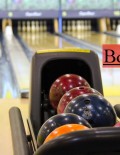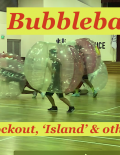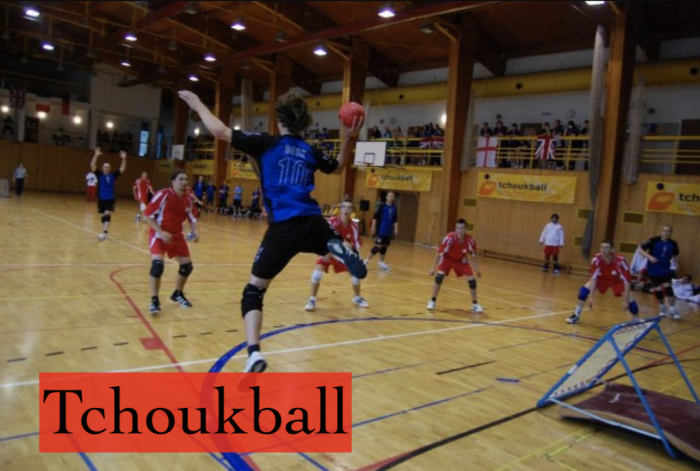Game Description
Introductory & Guidlines from:
https://allisonmouland.files.wordpress.com/2014/11/tchoukballpdf.pdf
https://www.jmu.edu/kinesiology/hpainstitute/documents/2012/2012HAPI-Tchoukball.pdf
Tchoukball Basics
Two teams of 7 players each (men or women) compete to score points with the team with the most points at the end winning the game. When a team gains a point, control of the ball is transferred to the other team. In tchoukball either team can score at either end of the court.
Lesson 1 – Tchoukball Basics Discuss the object of the game of tchoukball • Small group collaboration to come up with drills/minigames for warm-up or practice purposes • Continuous Rebound Relay Drill • Ensure students are aware of the ball and the angles it might rebound at • Ensure activities by students
Lesson 2 – Discuss the full rules for Tchoukball • Mini rebound game • Ball tag with no interference on defense • Ensure students are aware of the rules in each game • Ensure the space is sufficient and clear from items
Lesson 3 – Review the rules from previous day • Attempt a slowerpaced tchoukball game • Instruct students to be alert • Ensure playing area is clear of items
Lesson 4 – Students discuss strategy ideas in small groups • Discuss playing positions • Divide into teams and play games
Lesson 5 -Create a round robin tournament and keep track of points to engage students while they are assessed based on outcomes decided upon
Tchoukball Advanced
This advanced course puts participants into pairs and later Ideally a 5 v 5 game format (depending on the size of venue and class size on that day) games.
They will rehash the lessons learned in the Fun and Introductory lessons, and in addition get deeper into actual game play.
Game play is to promote sportsmanship amongst players, fitness and endurance level of the individual, and learning how to execute 2 basic shooting techniques
Students adapt themselves to catching rebounds at different angles
Students also acquire deeper understanding on how angles can increase the difficulty of catching rebounds
Students will acquire deeper knowledge of Tchoukball and its physical demands (muscular endurance, strength, agility etc.)
Character development through Sports (Teamwork, Fair play, Respect, Integrity, Determination, Discipline, Sportsmanship)
PARTNER SKILLS AND DRILLS
Partner Passing Skills and Drills
Toss and Catch – Each pair will collect a ball of choice. The teacher will designate the distance to start (i.e. – 3 steps)
and the direction (i.e. ‐ north/south). The teacher will review the proper throwing pattern (i.e. – review the cues) for the
type of throw being used by the students. The teacher will discuss the target for the tosses (knees or chest) depending
on the type of catch that the teacher requires (tick‐tock the catching clock).
Toss and Catch Challenges:
Catch and Switch – After a designated number of catches in a row, students will quick run and switch place
Catch and Spread – After a designated number of catches in a row, one partner will take a step back increasing the distance. If after two attempts to advance, the pair drops the ball before reaching the magic number, they will have to go back to the starting position and continue.
Catch and Run – Partners will throw and catch and either spell a vocabulary word or complete a multiplication table (i.e. ‐ 3’s to 30). When done, the students will run to end lines, perform a fitness activity and then come back and repeat the activity with a new academic challenge.
Sit and Throw – Partners will practice the basic overhand throw while seated. The teacher will focus on the proper arm pattern for the overhand throw. For a challenge, have student perform several curl‐ups each time they catch the ball.
TEAM GAMES
Team Toss and Catch
All students in the group will work together to pass a large collection of balls while continually moving. The teacher will use between 8‐10 balls (per group of 24 students). When the activity begins, students must jog and move
Long Pass Relay
Students will line up at an endline and get into groups of 4s. The purpose of this drill is to get practice throwing the ball further distances (throwing to the mid‐line is how the game is often started in Tchoukball). The first player in line will move across the field to the opposite endline, the next player in line will move to the midline, and the third player in line will have the ball. To start, the player with the ball will throw it to player 2 (midline) then run to the midline. Player two will throw the ball to player 1 at the opposite endline then run in the direction that they threw the ball (opposite endline). Player 1 will throw the ball to the midline (player 3). Player 3 will throw to player 4 (at the original endline) then run back to the original endline. The throwing and catching will continue with the player throwing always running in the direction that they throw the ball. It is critical that the ball moves from endline to opposite endline (always stopping at the midline) so that all partners will have equal turns.
Sumo Slam Ball
Split the group into two equal teams. Each student will wear colored pinnies to designate the team for which they are playing. The objective of the game is to score points by tagging any member of the opposing team while holding a soft ball. The team in possession of the ball must pass the ball in attempt to get it close enough to an opposing team member to tag them. The person holding the ball is allowed a pivot step but may not take additional steps after catching the ball. If a player from the other team is tagged or the ball is dropped, the other team will assume position of the ball. When the new team takes possession of the ball, the person who has the ball will hold the ball with two hands, touch the floor, then begin passing the ball. It is important to remember that at no time during the game can the defense interfere when a ball is being passed. The game can continue until a certain point is attained or a designated amount of time.
Tunnel Ball
The class will be split into two teams. Each team will wear different colored pinnies. The objective of the game is to bounce the ball between a teammate’s legs (while both feet are planted on the floor) and have the ball bounce a second time without being caught by the defense. If the ball bounces out of bounds, on the second bounce it does not count as a point. Again, the only way a ball can be moved by the offensive team is by passing. The player in control of the ball may take a pivot step but may not take any additional steps. When a point is scored or a ball is dropped, the person who has the ball will hold the ball with two hands, touch the floor, then begin passing the ball. It is important to remember that at no time during the game can the defense interfere when a ball is being passed. The game can continue until a certain point is attained or a designated amount of time.
Rebound Relay
Each student will find a partner. Each pair will line up on opposite sides of a frame (see diagram below). The partner on the right side of the frame will have the ball and when in front of the line, the player with the ball will throw the ball off the frame so that his/her partner can catch the ball. After the throw and catch, the pair will turn around and head to the frame on the opposite side of the playing area. The roles are then reversed for the next throw and catch. See diagram below.



